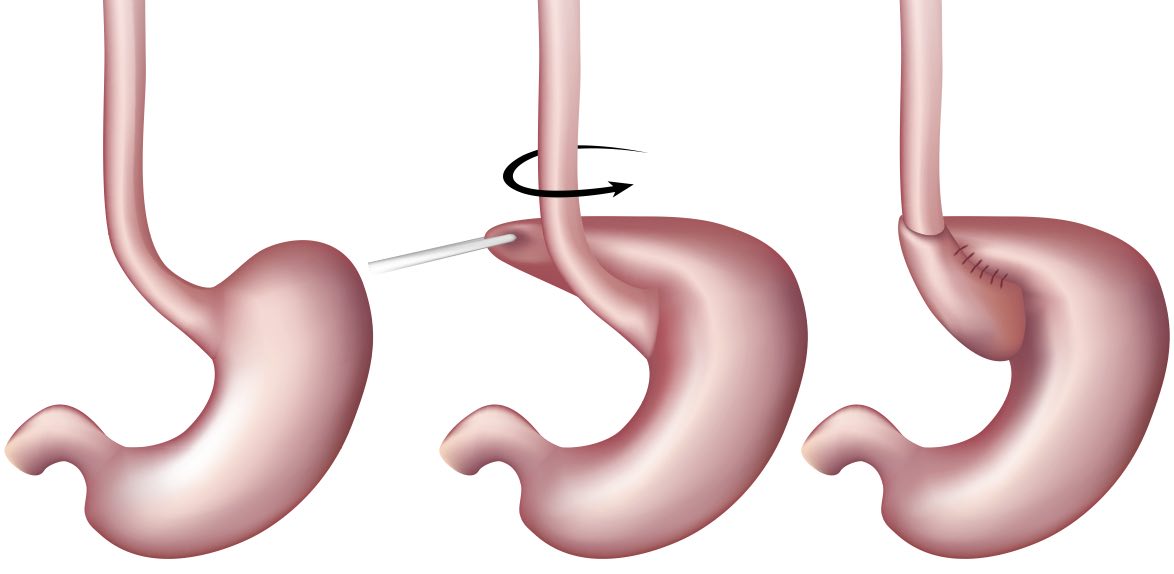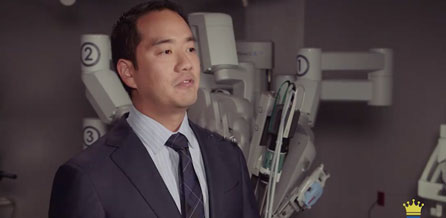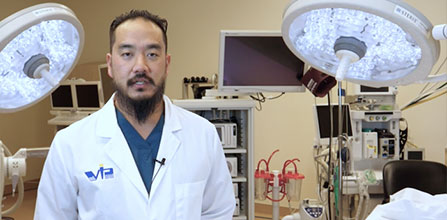Fundoplication Surgery for GERD
When conservative therapy such as lifestyle change or medication has failed to improve or eliminate the symptoms of Gastroesophageal Reflux Disease / GERD or chronic acid reflux, patients have the option of turning to a surgical procedure known as the fundoplication to reinforce the Lower Esophageal Sphincter or LES. Fundoplication involves wrapping the upper portion of the stomach, known as the fundus, around the lower part of the esophagus. The added pressure from this wrap allows the LES – the valve between the esophagus and the stomach, to work more efficiently and stop the upward motion of stomach acid that characterizes acid reflux.
In cases of a paraesophageal hiatal hernia, the fundoplication is the definitive first course of action.
Most patients will have heard of the Nissen Fundoplication which is a 360° wrap of the stomach around the esophagus. More recently, partial wraps have been employed for certain cases with similarly good results and fewer restrictions and complications. Common fundoplications are the Nissen: 360°, Toupet: 270° and Dor: 200°
How the Fundoplication Procedure Works
Surgical technology today has allowed for the fundoplication to be performed in a minimally invasive manner, meaning that a few small incisions are made in the abdomen versus a large single incision of open surgery. During the procedure, the fundus, or upper part of the stomach, is wrapped around the lower part of the esophagus. Once stitched in place, it adds bulk and pressure to the Lower Esophageal Sphincter (LES).
Because of the nature and location of the procedure, a hiatal hernia, if present, is repaired at the same time. A complete wrap around the esophagus offers the greatest chance for complete resolution of symptoms but also creates the most potential lifestyle concerns. Therefore, for selected patients, partial wraps of as little as 180° may be considered.
The fundoplication is extremely effective in reducing or eliminating the symptoms of GERD and represents a permanent solution in which most patients will not require further PPI therapy.

After GERD Surgery
The typical fundoplication is performed in about an hour, under general anesthesia and in the hospital setting. Most patients will require 1-2 nights in the hospital at which point they will be discharged with postoperative instructions. Patients will be on a modified diet progression for a few weeks after surgery, and will eventually return to normal diet.
Risks and Considerations of a Fundoplication
Complete or Nissen fundoplication, as well as partial fundoplication, all have the inherent risks of major abdominal surgery. However, improvements in technique have significantly reduced the risks of major complications like infection, blood loss, significant pain, and death.
Most of the considerations of a Nissen fundoplication revolve around lifestyle compromises after surgery. Most commonly patients may experience:
- Gas bloat syndrome may compromise the patient’s ability to expel swallowed air, leading to gas accumulation and discomfort. This is most common with a complete or Nissen fundoplication and is somewhat improved with partial fundoplications. Eventually, the gas does dissipate.
- Recurrence of symptoms due to failure of the plication may occur in fewer than 10% of patients. While this does not represent a serious complication, patients may begin to experience the symptoms of GERD once again and will require a subsequent corrective procedure.
- Vomiting becomes very painful, if not impossible, soon after surgery. Eventually, the ability to vomit may increase, but it continues to be painful.
Alternatives to the Nissen Fundoplication
Our practice was the first to be certified in the LINX Reflux Management System in the state of Nevada and we are one of the most experienced LINX practices in the country. The LINX is a medical device that minimizes many of the complications of a fundoplication. However, while the LINX is a viable option for many patients, those who do not qualify may benefit most from a fundoplication. Further, patients with very large hiatal hernias or patients with a paraesophageal hernia will require a Nissen Fundoplication, in most cases.
Contact our office to learn more about the benefits and risks of the fundoplication. Speaking with Drs. Tsuda and Ryan your options for the treatment of Gastroesophageal Reflux Disease are the first step toward a symptom free life.



